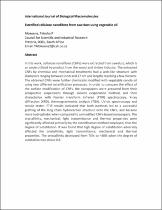JavaScript is disabled for your browser. Some features of this site may not work without it.
- ResearchSpace
- →
- Research Publications/Outputs
- →
- Journal Articles
- →
- View Item
| dc.contributor.author |
Mokoena, Teboho P

|
|
| dc.contributor.author |
Mathew, Maya J

|
|
| dc.date.accessioned | 2021-02-09T09:22:41Z | |
| dc.date.available | 2021-02-09T09:22:41Z | |
| dc.date.issued | 2020-04 | |
| dc.identifier.citation | Mokoena, T.P. & Mathew, M.J. 2020. Esterified cellulose nanofibres from saw dust using vegetable oil. <i>International Journal of Biological Macromolecules, vol. 148.</i> http://hdl.handle.net/10204/11732 | en_ZA |
| dc.identifier.uri | http://hdl.handle.net/10204/11732 | |
| dc.description.abstract | In this work, cellulose nanofibres (CNFs) were extracted from sawdust, which is an underutilized by-product from the wood and timber industry. The extracted CNFs by chemical and mechanical treatments had a web-like structure with diameters ranging between 2 nm and 27 nm and lengths reaching a few microns. The obtained CNFs were further chemically modified with vegetable canola oil using two different esterification processes. In order to compare the effect of the surface modification of CNFs, the nanopapers were prepared from their prospective suspensions through solvent evaporation method, and then characterize with Fourier transform infrared (FTIR) spectroscopy, X-ray diffraction (XRD), thermogravimetric analysis (TGA), UV-vis spectroscopy and tensile tester. FTIR results indicated that both methods led to a successful grafting of the long chain hydrocarbon structure onto the CNFs, and became more hydrophobic when compared to unmodified CNFs-based nanopapers. The crystallinity, mechanical, light transmittance and thermal properties were significantly affected primarily by the esterification method employed, thus the degree of substitution. It was found that high degree of substitution adversely affected the crystallinity, light transmittance, mechanical and thermal properties. The crystallinity decreased from 70% to <40% when the degree of substation was about 0.8. | en_US |
| dc.format | Abstract | en_US |
| dc.language.iso | en | en_US |
| dc.relation.uri | DOI: 10.1016/j.ijbiomac.2020.01.278 | en_US |
| dc.relation.uri | https://www.sciencedirect.com/science/article/pii/S0141813019375269?via%3Dihub | en_US |
| dc.relation.uri | https://pubmed.ncbi.nlm.nih.gov/32004608/ | en_US |
| dc.source | International Journal of Biological Macromolecules, vol. 148 | en_US |
| dc.subject | Cellulose nanofibres | en_US |
| dc.subject | Crystallinity | en_US |
| dc.subject | Esterification | en_US |
| dc.subject | Hydrophobicity | en_US |
| dc.subject | Vegetable oil | en_US |
| dc.title | Esterified cellulose nanofibres from saw dust using vegetable oil | en_US |
| dc.type | Article | en_US |
| dc.description.pages | 1109-1117 | en_US |
| dc.description.note | Due to copyright restrictions, the attached PDF file only contains the abstract of the full text item. For access to the full text item, please consult the publisher's website: https://www.sciencedirect.com/science/article/pii/S0141813019375269?via%3Dihub | en_US |
| dc.description.cluster | Chemicals | en_US |
| dc.description.impactarea | NS Materials for Sensing App | en_US |
| dc.description.impactarea | Advanced Polymer Composites | |
| dc.identifier.apacitation | Mokoena, T. P., & Mathew, M. J. (2020). Esterified cellulose nanofibres from saw dust using vegetable oil. <i>International Journal of Biological Macromolecules, vol. 148</i>, http://hdl.handle.net/10204/11732 | en_ZA |
| dc.identifier.chicagocitation | Mokoena, Teboho P, and Maya J Mathew "Esterified cellulose nanofibres from saw dust using vegetable oil." <i>International Journal of Biological Macromolecules, vol. 148</i> (2020) http://hdl.handle.net/10204/11732 | en_ZA |
| dc.identifier.vancouvercitation | Mokoena TP, Mathew MJ. Esterified cellulose nanofibres from saw dust using vegetable oil. International Journal of Biological Macromolecules, vol. 148. 2020; http://hdl.handle.net/10204/11732. | en_ZA |
| dc.identifier.ris | TY - Article AU - Mokoena, Teboho P AU - Mathew, Maya J AB - In this work, cellulose nanofibres (CNFs) were extracted from sawdust, which is an underutilized by-product from the wood and timber industry. The extracted CNFs by chemical and mechanical treatments had a web-like structure with diameters ranging between 2 nm and 27 nm and lengths reaching a few microns. The obtained CNFs were further chemically modified with vegetable canola oil using two different esterification processes. In order to compare the effect of the surface modification of CNFs, the nanopapers were prepared from their prospective suspensions through solvent evaporation method, and then characterize with Fourier transform infrared (FTIR) spectroscopy, X-ray diffraction (XRD), thermogravimetric analysis (TGA), UV-vis spectroscopy and tensile tester. FTIR results indicated that both methods led to a successful grafting of the long chain hydrocarbon structure onto the CNFs, and became more hydrophobic when compared to unmodified CNFs-based nanopapers. The crystallinity, mechanical, light transmittance and thermal properties were significantly affected primarily by the esterification method employed, thus the degree of substitution. It was found that high degree of substitution adversely affected the crystallinity, light transmittance, mechanical and thermal properties. The crystallinity decreased from 70% to <40% when the degree of substation was about 0.8. DA - 2020-04 DB - ResearchSpace DP - CSIR J1 - International Journal of Biological Macromolecules, vol. 148 KW - Cellulose nanofibres KW - Crystallinity KW - Esterification KW - Hydrophobicity KW - Vegetable oil LK - https://researchspace.csir.co.za PY - 2020 T1 - Esterified cellulose nanofibres from saw dust using vegetable oil TI - Esterified cellulose nanofibres from saw dust using vegetable oil UR - http://hdl.handle.net/10204/11732 ER - | en_ZA |
| dc.identifier.worklist | 23764 |






